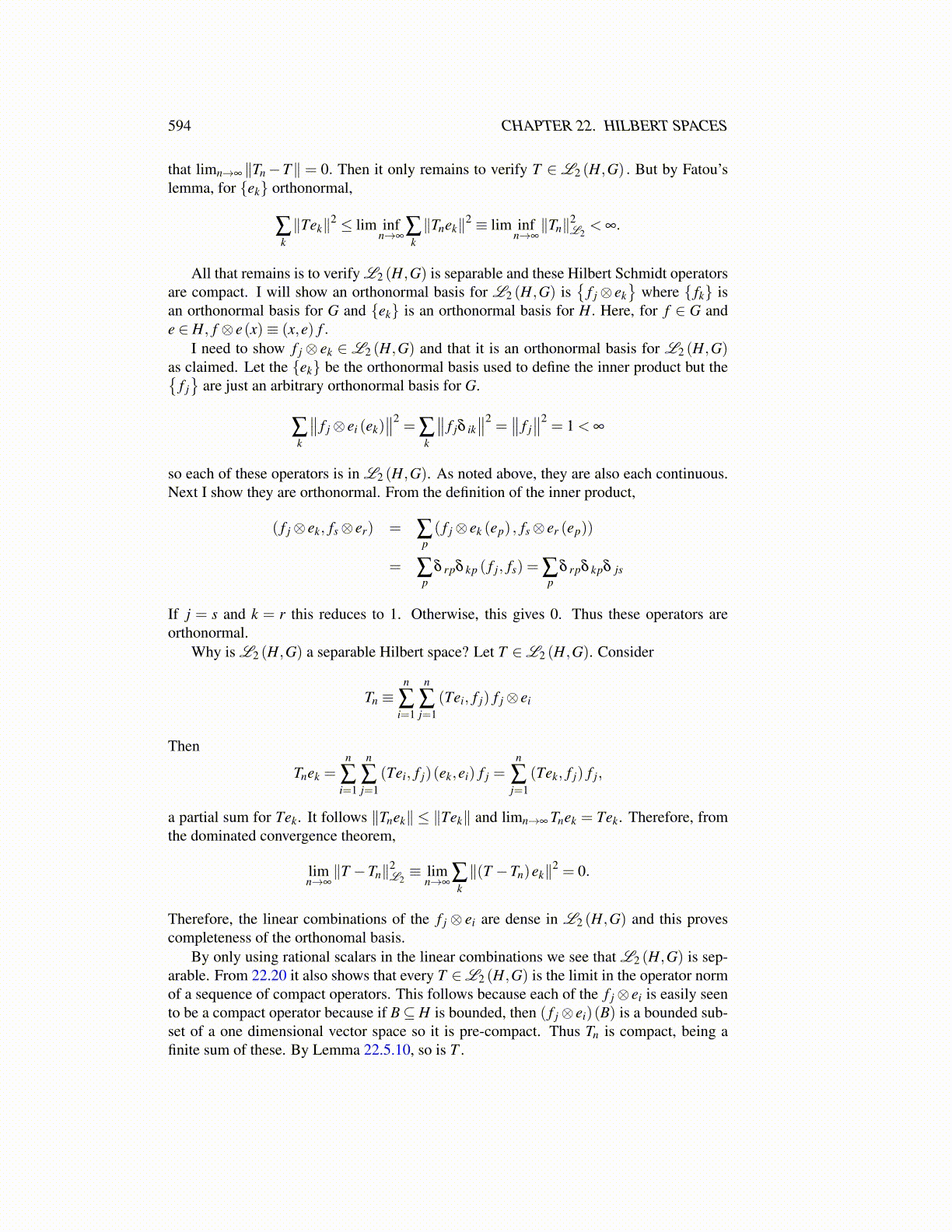
594 CHAPTER 22. HILBERT SPACES
that limn→∞ ∥Tn−T∥ = 0. Then it only remains to verify T ∈L2 (H,G) . But by Fatou’slemma, for {ek} orthonormal,
∑k∥Tek∥2 ≤ lim inf
n→∞∑k∥Tnek∥2 ≡ lim inf
n→∞∥Tn∥2
L2< ∞.
All that remains is to verify L2 (H,G) is separable and these Hilbert Schmidt operatorsare compact. I will show an orthonormal basis for L2 (H,G) is
{f j⊗ ek
}where { fk} is
an orthonormal basis for G and {ek} is an orthonormal basis for H. Here, for f ∈ G ande ∈ H, f ⊗ e(x)≡ (x,e) f .
I need to show f j ⊗ ek ∈L2 (H,G) and that it is an orthonormal basis for L2 (H,G)as claimed. Let the {ek} be the orthonormal basis used to define the inner product but the{
f j}
are just an arbitrary orthonormal basis for G.
∑k
∥∥ f j⊗ ei (ek)∥∥2
= ∑k
∥∥ f jδ ik∥∥2
=∥∥ f j∥∥2
= 1 < ∞
so each of these operators is in L2 (H,G). As noted above, they are also each continuous.Next I show they are orthonormal. From the definition of the inner product,
( f j⊗ ek, fs⊗ er) = ∑p( f j⊗ ek (ep) , fs⊗ er (ep))
= ∑p
δ rpδ kp ( f j, fs) = ∑p
δ rpδ kpδ js
If j = s and k = r this reduces to 1. Otherwise, this gives 0. Thus these operators areorthonormal.
Why is L2 (H,G) a separable Hilbert space? Let T ∈L2 (H,G). Consider
Tn ≡n
∑i=1
n
∑j=1
(Tei, f j) f j⊗ ei
Then
Tnek =n
∑i=1
n
∑j=1
(Tei, f j)(ek,ei) f j =n
∑j=1
(Tek, f j) f j,
a partial sum for Tek. It follows ∥Tnek∥ ≤ ∥Tek∥ and limn→∞ Tnek = Tek. Therefore, fromthe dominated convergence theorem,
limn→∞∥T −Tn∥2
L2≡ lim
n→∞∑k∥(T −Tn)ek∥2 = 0.
Therefore, the linear combinations of the f j ⊗ ei are dense in L2 (H,G) and this provescompleteness of the orthonomal basis.
By only using rational scalars in the linear combinations we see that L2 (H,G) is sep-arable. From 22.20 it also shows that every T ∈L2 (H,G) is the limit in the operator normof a sequence of compact operators. This follows because each of the f j⊗ ei is easily seento be a compact operator because if B⊆H is bounded, then ( f j⊗ ei)(B) is a bounded sub-set of a one dimensional vector space so it is pre-compact. Thus Tn is compact, being afinite sum of these. By Lemma 22.5.10, so is T .